SAT 2016
CHAPTER 9
THE SAT MATH: ADVANCED MATHEMATICS
Skill 4: Working with Rational Expressions
Lesson 12: Interpreting and computing with rational expressions
Which of the following is equivalent to  for all x greater than 0?
for all x greater than 0?
A) 
B) 
C) 
D) 
When adding, subtracting, multiplying, or dividing rational expressions, just follow the rules for working with fractions.
• When adding or subtracting fractions, first get a common denominator, then combine numerators.
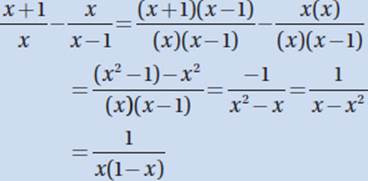
• When multiplying fractions, just multiply straight across.

• To divide by a fraction, just multiply by its reciprocal.

(Medium) To simplify this difference of fractions, we must find a common denominator.

So the correct answer is (C).
If  is equivalent to
is equivalent to  for all x, which of the following is equivalent to B?
for all x, which of the following is equivalent to B?
A) 3x – 1
B) 3x + 1
C) 9x2
D) 9x2 – 1
(Hard) It helps to notice that the given rational expression is “improper,” but that the transformed expression is not. Recall that an “improper fraction,” like 5/3, is one in which the numerator is larger than the denominator. Such fractions can also be expressed as “mixed numbers,” which include an integer and a “proper fraction:” 5/3 = 1 ⅔. Similarly, an “improper rational expression” is one in which the degree of the numerator is greater than the degree of the denominator. In the expression  , the numerator has a degree of 2 and the denominator has a degree of 1. Just as with improper fractions, we can convert this to a “mixed” expression by just doing the division:
, the numerator has a degree of 2 and the denominator has a degree of 1. Just as with improper fractions, we can convert this to a “mixed” expression by just doing the division:
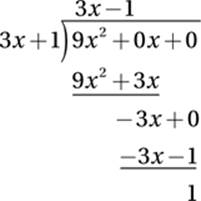
which means that  equals
equals  . Therefore, the correct answer is (A).
. Therefore, the correct answer is (A).

Let x represent the time, in hours, it takes pump A to fill a standard tank, and let y represent the time, in hours, it takes pump A and pump B, working together, to fill the same standard tank. If the equation above represents this situation, then b must represent
A) the time, in hours, it takes pump B, working alone, to fill the standard tank
B) the portion of the standard tank that pump B fills when the pumps work together to fill the entire standard tank
C) the rate, in standard tanks per hour, of pump B
D) the difference between the rates, in standard tanks per hour, of pump B and pump A
Rational expressions are often used to express rates. (Remember: rate, rational, and ratio all derive from the same Latin root.) When working with rational expressions that represent real quantities, it often helps to think in terms of the rate-units that they represent.
For instance, if t represents the amount of time, in hours, it takes someone to paint n rooms, then t/n represents the number of “hours per room” and n/t represents the number of “rooms per hour.”
(Medium-hard) You may find it helpful to review Chapter 8, Lesson 5, “Rates and unit rates” before tackling this problem. We are told that x represents the number of “hours per tank” for pump A, that is, the number of hours it takes pump A to fill one standard tank. Therefore, its reciprocal, 1/x, must represent the number of “tanks per hour” for pump A, that is, the number of tanks (or fraction of a tank) that pump A can fill in one hour. Likewise, since y represents the number of “hours per tank” when the two pumps work together, 1/y must represent the number of “tanks per hour” that the two pumps can fill when working together.
The essential fact in this situation is that “the rate (in tanks per hour) at which the two pumps work together must equal the sum of the rates (in tanks per hour) of the two pumps working separately.” (For instance, if pump A can fill 2 tanks per hour and pump B can fill 3 tanks per hour, then working together they can fill 5 tanks per hour.)
Since the given equation essentially says, “the rate of pump A plus b = the rate of pump A and pump B working together,” b must represent the rate (in tanks per hour) of pump B. Therefore, the correct answer is (C).
Lesson 13: Simplifying rational expressions
If x = 3a and a ≠ 2, which of the following is equivalent to 
A) 
B) 
C) 
D) 
Since rational expressions are just fractions (although perhaps complicated ones), we simplify them exactly the same way we simplify any fraction, that is, by cancelling common factors in the numerator and denominator (which is equivalent to dividing by 1), or multiplying numerator and denominator by a convenient factor (which is equivalent to multiplying by 1).
• Factoring and cancelling common factors:

• Multiplying by a common factor:

(Medium) This question is asking us to translate an expression in x into an expression in a, which requires making a substitution. However, it is a bit simpler if we don”t substitute right away, but instead simplify the given expression:

Factor:

Cancel common factor:

Substitute x = 3a:

Divide numerator and denominator by 3:

Therefore the answer is (A). Bonus question: Why did the question have to mention that a ≠ 2?
If  for all x > 3, where a and b are constants, what is the value of ab?
for all x > 3, where a and b are constants, what is the value of ab?
A) ![]()
B) ![]()
C) ![]()
D) ![]()
(Medium-hard) The expression on the left side of the equation is obnoxious and in desperate need of simplification:
Factor:
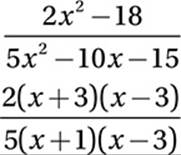
Cancel common factor (okay since x > 3):

Divide numerator and denominator by 5:

This last step, which may seem strange, is important because it shows us how the two sides of the equation “match up.” If this equation is to be true for “all x > 3” then a must equal 2/5 and b must equal 3. Therefore, ab = (2/5)(3) = 6/5, and the correct answer is (C). Bonus question: Why did the question mention that x > 3?
Lesson 14: Solving rational equations
If x > 0 and  , what is the value of x? [No calculator]
, what is the value of x? [No calculator]
A) ![]()
B) ![]()
C) ![]()
D) ![]()
When solving an equation that includes fractions or rational expressions, you may find it helpful to simplify the equation by multiplying both sides by the “common denominator” (that is, the common multiple of the denominators).

Multiply by 5x:

Distribute:

Simplify:
x2 + 5 = 10x
Notice that, in this case, the equation simplifies to a quadratic, which is relatively easy to work with.
(Hard) Let”s apply this strategy to our equation:

Multiply by

Distribute:

Simplify:
(x + 1) – (x – 1) = 2x2 – 2
Simplify:
2 = 2x2 – 2
Add 2:
4 = 2x2
Divide by 2:
2 = x2
Take the square root:
![]()
But since the equation states that x > 0, the correct answer is (A).
The function f is defined by the equation f(x) = x2 – 3x – 18 and the function h is defined by the equation  . For what value of x does h(x) = 6?
. For what value of x does h(x) = 6?
A) –6
B) –3
C) 0
D) 9
(Hard) The first thing we should try to do is simplify the expression for h(x).

Substitute f(x) = x2 – 3x – 18:

Factor using Product-Sum Method:

Cancel common factor:

Solve for x if h(x) = 6:

Multiply by 2:
12 = x + 3
Subtract 3:
9 = x
Therefore, the correct answer is (D).
Exercise Set 5 (No Calculator)
1
If  , what is the value of y?
, what is the value of y?

2
If  and x > 0, what is the value of x?
and x > 0, what is the value of x?

3
If  , what is the value of x2?
, what is the value of x2?

4
If  , what is the value of z?
, what is the value of z?

5
Let g(x) = x2 – 9x + 18 and  , where a is a constant. If h(4) =
, where a is a constant. If h(4) =  , what is the value of a?
, what is the value of a?

6
If  for all values of x greater than 1, what is the value of a + b?
for all values of x greater than 1, what is the value of a + b?

7
Which of the following is equivalent to  for all x greater than 1?
for all x greater than 1?
A) 
B) 
C) 
D) 
8
For how many distinct integer values of n is 
A) Zero
B) One
C) Two
D) Three
9
If  and a > 1, which of the following is equivalent to
and a > 1, which of the following is equivalent to 
A) 
B) 
C) 
D) 
Exercise Set 5 (Calculator)
10
If  , what is the value of x2 – 10x?
, what is the value of x2 – 10x?

11
For how many positive integer values of k is 

12
If g(x) = x2 – 9x + 18 and  , what is the value of h(9)?
, what is the value of h(9)?

13
If  , what is the value of
, what is the value of 

14
If  , what is the value of c2?
, what is the value of c2?

15
If  for all values of x, what is the value of a?
for all values of x, what is the value of a?

16
Which of the following is equivalent to  for all positive values of b?
for all positive values of b?
A) 
B) 
C) 
D) 
17
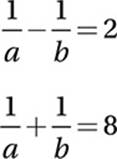
Given the system above, what is the value of a + b?
A) ![]()
B) ![]()
C) ![]()
D) ![]()
18
If one proofreader takes n hours to edit 30 pages and another takes m hours to edit 50 pages, and together they can edit x pages per hour, which of the following equations must be true?
A) 
B) 
C) 
D) 
EXERCISE SET 5 ANSWER KEY
No Calculator
1. 6/5 or 1.2

Multiply by 45:
15 – 9 = 5y
(45 is the least common multiple of the denominators.)
Simplify:
6 = 5y
Divide by 5:
6/5 = y
2. 7

Multiply by 24(x + 1)(x – 1):
24x(x – 1)+ 24(x + 1) = 25(x + 1)(x – 1)
Distribute:
24x2 – 24x + 24x + 24 = 25x2 – 25
Gather like terms:
0 = x2 – 49
Add 49:
49 = x2
Take square root:
±7 = x
Since x must be positive, x = 7.
3. 13/2 or 6.5

Multiply by 5(x – 2)(x + 2):
5(x + 2) – 5(x – 2) = 8(x – 2)(x + 2)
Distribute:
5x + 10 – 5x + 10 = 8x2– 32
Subtract 20 and simplify:
0 = 8x2– 52
Add 52:
52 = 8x2
Divide by 8:
52/8 = 13/2 = x2
Remember, the question asks for the value of x2, not x, so don”t worry about taking the square root.
4. 6/17 or .353

Multiply by 6z:
12z – 6 = –5z
Add 5z and 6:
17z = 6
Divide by 17:
z = 6/17
5. 28

Use definition of g:

Simplify:

Cross-multiply:
4 –a = –24
Add 24 and a:
28 = a
6. 5

Combine fractions:

Simplify:

Since  must equal
must equal  for all values of x, a = 3 and b = 2, so a + b = 5.
for all values of x, a = 3 and b = 2, so a + b = 5.
7. D
Since (1 - x) = -(x - 1):

8. C

Recall from Chapter 7, Lesson 9, on solving inequalities, that we need to consider two conditions. First, if n + 2 is positive (that is, n > –2), we can multiply on both sides without “flipping” the inequality:
n + 5 > 2n + 4
Subtract n and 4:
1 > n
So n must be between –2 and 1, and the integer values of –1 and 0 are both solutions. Next, we consider the possibility n + 2 is negative (that is, n < –2), and therefore multiplying both sides by n + 2 requires “flipping” the inequality:
n + 5 < 2n + 4
Subtract n and 4:
1 < n
But there are no numbers that are both less than –2 and greater than 1, so this yields no new solutions.
9. C

Factor:

Cancel common factors:

Substitute x = 4a:

Cancel common factor:

Calculator
10. 15

Multiply by 5x:
x2 – 15 = 10x
Add 15, subtract 10x:
x2 – 10x = 15
Notice that you should not worry about solving for x!
11. 2

Use common base:
10–k > 10–3
Exponential Law #10:
–k > –3
Multiply by –1:
k < 3
Therefore, the two positive integer solutions are 1 and 2.
12. 3/14 or .214

Use definition of g:

Simplify:

13. 81/2 or 40.5

Combine fractions:

Simplify:

Multiply by 9/2:

14. 5

Convert to ×:

Multiply:

Multiply by c2 – 1:
2c2 = 10
Divide by 2:
c2 = 5
15. 2 Notice that the right-hand side of the equation is the “proper” form of the “improper” fraction on the left, and that a is the remainder when the division of the polynomials is completed:
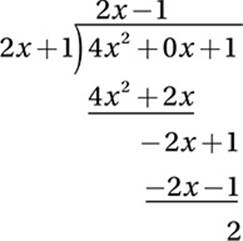
16. D

Common denominator:

Combine:

17. C

Add equations:

Multiply by a:

Divide by 10:
2 = 10a
1/5 = a
Subtract equations:

Multiply by –b:
2 = 6b
Divide by 6:
1/3 = b
Therefore, a + b = 1/5 + 1/3 = 8/15.
18. A The number of pages they can edit together in an hour must equal the sum of the number of pages they can edit separately. The number of pages the first proofreader can edit per hour is 30/n, and the number of pages the second proofreader can edit per hour is 50/m. Since they can edit x pages per hour together,  .
.
NOTE: You can avoid the most common mistakes with this problem by paying attention to the units of each term. The units of two sides, as well as the unit of each term in a sum or difference, must “match.” Notice that the unit for all of the terms is pages/hour.